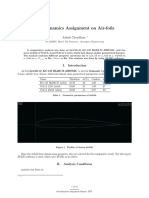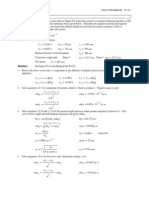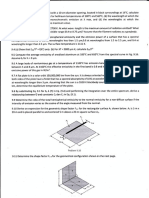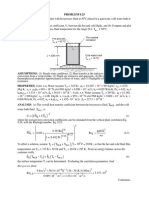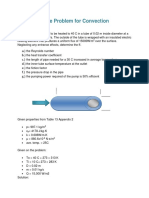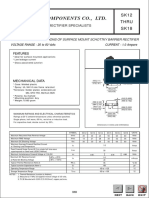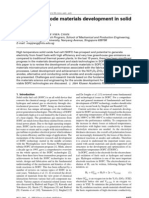Assignment 4
Uploaded by
mahmoud EissaAssignment 4
Uploaded by
mahmoud EissaSUEZ CANAL University
Faculty of Engineering
Mechanical power Department
Fluid Mechanics and Hydraulics Machines
Assignment (4)
1) Water is to be siphoned through a tube 1 m long and 2
mm in diameter, as in Fig. P1. Is there any height H for which
the flow might not be laminar? What is the flow rate if H = 50 cm?
Neglect the tube curvature.
2) For the configuration shown in Fig. P2, the fluid is ethyl
alcohol at 20°C, and the tanks are very wide. Find the flow rate
which occurs in m3/h. Is the flow laminar?
3) Let us attack Prob.2 in symbolic fashion, using Fig. P3. All
parameters are constant except the upper tank depth Z(t). Find an
expression for the flow rate Q(t) as a function of Z(t). Set up a
differential equation, and solve for the time t0 to drain the upper
tank completely. Assume quasi-steady laminar flow.
4) SAE 10 oil at 20°C flows through the 4-cm-diamete vertical pipe
of Fig. P4.For the mercury manometer reading h = 42 cm shown,
(a) calculate the volume flow rate in m3/h, and (b) state the
direction of flow.
5) A 70 percent efficient pump delivers water at 20°C from one
reservoir to another 20 ft higher, as in Fig. P5. The piping system
consists of 60 ft of galvanized- iron 2-in pipe, a reentrant entrance,
two screwed 90° long-radius elbows, a screwed- open gate valve,
and a sharp exit. What is the input power required in horsepower
with and without a 6° well-designed conical expansion added to
the exit? The flow rate is 0.4 ft3/s.
Dr.Eng. Tamer Nabil
Page Eng. Ahmed Elsaei
6) The reservoirs in Fig. P6. are connected by cast-iron pipes joined
abruptly, with sharp-edged entrance and exit. Including minor
losses, estimate the flow of water at 20°C if the surface of
reservoir 1 is 45 ft higher than that of reservoir 2.
7) The water pump in Fig. P7. maintains a pressure of 6.5 psig at
point 1. There is a filter, a half-open disk valve, and two regular
screwed elbows. There are 80 ft of 4-inch diameter commercial
steel pipe. (a) If the flow rate is 0.4 ft3/s, what is the loss
coefficient of the filter? (b) If the disk valve is wide open and
Kfilter = 7, what is the resulting flow rate?
8) For the parallel-pipe system of Fig. P8., each pipe is cast iron,
and the pressure drop p1 − p2 = 3 lbf/in . Compute the total
flow rate between 1 and 2 if the fluid is SAE 10 oil at 20°C.
9) The parallel galvanized-iron pipe system of Fig. P9. delivers
water at 20°C with a total flow rate of 0.036 m3/s. If the pump is
wide open and not running, with a loss coefficient K = 1.5,
determine (a) the flow rate in each pipe and (b) the overall
pressure drop.
10) Modify Prob.9 as follows: Let the pump be running and
delivering 45 kW to the flow in pipe 2. The fluid is gasoline at 20°C.
Determine (a) the flow rate in each pipe, and (b) the overall
pressure drop.
11) In Fig. P.11 all pipes are 8-cm-diameter cast iron. Determine
the flow rate from reservoir (1) if valve C is (a) closed; and (b)
open, with Kvalve = 0.5.
12) For the piping system of Fig. P.12, all pipes are concrete
with a roughness of 0.04 inch. Neglecting minor losses, compute
the overall pressure drop p1 − p2 in lbf/in2. The flow rate is 20
ft3/s of water at 20°C.
Dr.Eng. Tamer Nabil
Page Eng. Ahmed Elsaei
13) Three cast-iron pipes are laid in parallel with these
dimensions:
Pipe 1: L1 = 800 m d1 = 12 cm
Pipe 2: L2 = 600 m d2 = 8 cm
Pipe 3: L3 = 900 m d3 = 10 cm
3
The total flow rate is 200 m /h of water at 20°C. Determine (a) the
flow rate in each pipe; and (b) the pressure drop across the
system.
14) Consider the three-reservoir system of Fig. P6.121 with the
following data:
L1 = 95 m L2 = 125 m L3 = 160 m
z1 = 25 m z2 = 115 m z3 = 85 m
All pipes are 28-cm-diameter unfinished concrete (ε = 1 mm). Compute
the steady flow rate in all pipes for water at 20°C.
15) Modify Prob. 14 by reducing the diameter to 15 cm, with ε
= 1 mm. Compute the flow rate in each pipe. They all reduce,
compared to Prob. 14, by a factor of about 5.2. Can you explain
this?
16) Modify Prob. 14 on the previous page as follows. Let z3 be
unknown and find its value such that the flow rate in pipe 3 is 0.2
m3/s toward the junction. (This problem is best suited for
computer iteration.)
17) In the five-pipe horizontal network of Fig. P.17, assume that
all pipes have a friction factor f = 0.025. For the given inlet and
exit flow rate of 2 ft3/s of water at 20°C, determine the flow
rate and direction in all pipes. If pA = 120 lbf/in gage, determine
the pressures at points B, C, and D.
Dr.Eng. Tamer Nabil
Page Eng. Ahmed Elsaei
18) An engineer who took college fluid mechanics on a pass-fail
basis has placed the static pressure hole far upstream of the
stagnation probe, as in Fig. P.18, thus contaminating the pitot
measurement ridiculously with pipe friction losses. If the pipe flow
is air at 20°C and 1 atm and the manometer fluid is Meriam red oil
(SG = 0.827), estimate the air centerline velocity for the given
manometer reading of 16 cm. Assume a smooth-walled tube.
19) The shower head in Fig. P.19 delivers water at 50°C. An
orifice-type flow reducer is to be installed. The up- stream
pressure is constant at 400 kPa. What flow rate, in gal/min,
results without the reducer? What reducer orifice diameter would
decrease the flow by 40 percent?
20) Air flows through a 6-cm-diameter smooth pipe which has a
2 m-long perforated section containing 500 holes (diameter 1
mm), as in Fig. P20. Pressure outside the pipe is sea-level
standard air. If p1 = 105 kPa and Q1 = 110 m3/h, estimate p2
and Q2, assuming that the holes are approximated by thin-
plate orifices. Hint: A momentum control volume may be very
useful.
21) In a laboratory experiment, air at 20°C flows from a large
tank through a 2- cm-diameter smooth pipe into a sea-level
atmosphere, as in Fig. P.21. The flow is metered by a long-radius
nozzle of 1-cm diameter, using a manometer with Meriam red oil
(SG = 0.827). The pipe is 8 m long. The measurements of tank
pressure and manometer height are as follows:
ptank, Pa (gage): 60 320 1200 2050 2470 3500 4900
hmano, mm: 6 38 160 295 380 575 820
Use this data to calculate the flow rates Q and Reynolds numbers
ReD and make a plot of measured flow rate versus tank pressure.
Is the flow laminar or turbulent? Compare the data with
theoretical results obtained from the Moody chart, including
minor losses .Discuss.
Dr.Eng. Tamer Nabil
Page Eng. Ahmed Elsaei
Assignment's Figures
Dr.Eng. Tamer Nabil
Page Eng. Ahmed Elsaei
Dr.Eng. Tamer Nabil
Page Eng. Ahmed Elsaei
Dr.Eng. Tamer Nabil
Page Eng. Ahmed Elsaei
Dr.Eng. Tamer Nabil
Page Eng. Ahmed Elsaei
Dr.Eng. Tamer Nabil
Page Eng. Ahmed Elsaei
Dr.Eng. Tamer Nabil
Page Eng. Ahmed Elsaei
You might also like
- Design of Air-Conditioning Apparatus: TransferNo ratings yetDesign of Air-Conditioning Apparatus: Transfer46 pages
- Criteria For Ductile Fracture and Their ApplicationsNo ratings yetCriteria For Ductile Fracture and Their Applications17 pages
- Fundamentos de Mec Anica de Fluidos Primer Examen Parcial: Figure P1.24No ratings yetFundamentos de Mec Anica de Fluidos Primer Examen Parcial: Figure P1.242 pages
- Diaphragm Pump:Design & Working: Prepared By:-Sidra HafeezNo ratings yetDiaphragm Pump:Design & Working: Prepared By:-Sidra Hafeez21 pages
- Solved - A 2.1-M-Long, 0.2-Cm-Diameter Electrical Wire Extends A...No ratings yetSolved - A 2.1-M-Long, 0.2-Cm-Diameter Electrical Wire Extends A...3 pages
- Basic Physical Laws Volume FL Ow: D DT D DTNo ratings yetBasic Physical Laws Volume FL Ow: D DT D DT24 pages
- Exercicios Ch04 FundamentalsEngineeringThermodynamics7e PDFNo ratings yetExercicios Ch04 FundamentalsEngineeringThermodynamics7e PDF23 pages
- Fluid-Mechanics-White-Book - (WWW - Konkur.in) Export (1) - Merged PDFNo ratings yetFluid-Mechanics-White-Book - (WWW - Konkur.in) Export (1) - Merged PDF88 pages
- Tarea 2. Mecanismos de Transferencia de Calor y Balance Macroscópico de EnergíaNo ratings yetTarea 2. Mecanismos de Transferencia de Calor y Balance Macroscópico de Energía3 pages
- Design and Concepts of BYU Rocketry's Launch Vehicle: Team 84 Project Technical Report To The 2018 Spaceport America CupNo ratings yetDesign and Concepts of BYU Rocketry's Launch Vehicle: Team 84 Project Technical Report To The 2018 Spaceport America Cup52 pages
- Castellan Physical Chemistry (PDFDrive - Com) - Halaman-51-83No ratings yetCastellan Physical Chemistry (PDFDrive - Com) - Halaman-51-8333 pages
- ME4202501 Thermodynamics I, Fall Term 2015 Practice 5No ratings yetME4202501 Thermodynamics I, Fall Term 2015 Practice 51 page
- Apunte 7 Más Ejercicios de Manometria 0810 2020 PandemiaNo ratings yetApunte 7 Más Ejercicios de Manometria 0810 2020 Pandemia2 pages
- Boiler Plant and Distribution System Optimization ManualNo ratings yetBoiler Plant and Distribution System Optimization Manual307 pages
- Influence of Liquid Sodium On Mechanical Properties of Steels, Refractory Alloys and CeramicsNo ratings yetInfluence of Liquid Sodium On Mechanical Properties of Steels, Refractory Alloys and Ceramics39 pages
- Project.1: Solved by .. Ahmed Saad Abd Elhamid Level 3No ratings yetProject.1: Solved by .. Ahmed Saad Abd Elhamid Level 310 pages
- Air Flow M KG/S Pressure Inlet Toccp Bar Temperature Inlet Tocct K Temperature Outlet From CCT K Pressure Losses in CC PNo ratings yetAir Flow M KG/S Pressure Inlet Toccp Bar Temperature Inlet Tocct K Temperature Outlet From CCT K Pressure Losses in CC P1 page
- Consider The Following Characteristic Equation + K + +s+1 0 Determine The Range of K For StabilityNo ratings yetConsider The Following Characteristic Equation + K + +s+1 0 Determine The Range of K For Stability1 page
- Refrigeration Systems: Dr. Khalid RamzyNo ratings yetRefrigeration Systems: Dr. Khalid Ramzy26 pages
- Anderson and Burge The Handbook of Optics FabricationNo ratings yetAnderson and Burge The Handbook of Optics Fabrication36 pages
- CE Board Nov 2020 - Geotechnical Engineering - Set 1 PDF0% (1)CE Board Nov 2020 - Geotechnical Engineering - Set 1 PDF3 pages
- b1 Ko20032 Harsha Vardhan Bhartiya City Sez 3No ratings yetb1 Ko20032 Harsha Vardhan Bhartiya City Sez 329 pages
- (Universitext) Pierre Brémaud - Probability Theory and Stochastic Processes (2020, Springer)100% (5)(Universitext) Pierre Brémaud - Probability Theory and Stochastic Processes (2020, Springer)717 pages
- Download ebooks file Problems And Solutions In Optics And Photonics 1st Edition Ghatak all chapters100% (8)Download ebooks file Problems And Solutions In Optics And Photonics 1st Edition Ghatak all chapters82 pages
- Universal Motor Controller Designing For Washing MachinesNo ratings yetUniversal Motor Controller Designing For Washing Machines5 pages
- Psoc 3 and Psoc 5Lp - Temperature Measurement With An RTDNo ratings yetPsoc 3 and Psoc 5Lp - Temperature Measurement With An RTD26 pages
- Cation Exchange Resin DUOLITE C20 PDS PDFNo ratings yetCation Exchange Resin DUOLITE C20 PDS PDF4 pages
- Microstructure and Corrosion Characterization of Weld Metal in StainlessNo ratings yetMicrostructure and Corrosion Characterization of Weld Metal in Stainless11 pages
- A Review of Anode Materials Development in Solid100% (1)A Review of Anode Materials Development in Solid35 pages
- Density Lab Objective: To Measure The Mass and Volume of Various Metals, Then Graph The Data To Observe TheNo ratings yetDensity Lab Objective: To Measure The Mass and Volume of Various Metals, Then Graph The Data To Observe The3 pages
- Criteria For Ductile Fracture and Their ApplicationsCriteria For Ductile Fracture and Their Applications
- Fundamentos de Mec Anica de Fluidos Primer Examen Parcial: Figure P1.24Fundamentos de Mec Anica de Fluidos Primer Examen Parcial: Figure P1.24
- Diaphragm Pump:Design & Working: Prepared By:-Sidra HafeezDiaphragm Pump:Design & Working: Prepared By:-Sidra Hafeez
- Solved - A 2.1-M-Long, 0.2-Cm-Diameter Electrical Wire Extends A...Solved - A 2.1-M-Long, 0.2-Cm-Diameter Electrical Wire Extends A...
- Exercicios Ch04 FundamentalsEngineeringThermodynamics7e PDFExercicios Ch04 FundamentalsEngineeringThermodynamics7e PDF
- Fluid-Mechanics-White-Book - (WWW - Konkur.in) Export (1) - Merged PDFFluid-Mechanics-White-Book - (WWW - Konkur.in) Export (1) - Merged PDF
- Tarea 2. Mecanismos de Transferencia de Calor y Balance Macroscópico de EnergíaTarea 2. Mecanismos de Transferencia de Calor y Balance Macroscópico de Energía
- Design and Concepts of BYU Rocketry's Launch Vehicle: Team 84 Project Technical Report To The 2018 Spaceport America CupDesign and Concepts of BYU Rocketry's Launch Vehicle: Team 84 Project Technical Report To The 2018 Spaceport America Cup
- Castellan Physical Chemistry (PDFDrive - Com) - Halaman-51-83Castellan Physical Chemistry (PDFDrive - Com) - Halaman-51-83
- ME4202501 Thermodynamics I, Fall Term 2015 Practice 5ME4202501 Thermodynamics I, Fall Term 2015 Practice 5
- Apunte 7 Más Ejercicios de Manometria 0810 2020 PandemiaApunte 7 Más Ejercicios de Manometria 0810 2020 Pandemia
- Boiler Plant and Distribution System Optimization ManualBoiler Plant and Distribution System Optimization Manual
- Influence of Liquid Sodium On Mechanical Properties of Steels, Refractory Alloys and CeramicsInfluence of Liquid Sodium On Mechanical Properties of Steels, Refractory Alloys and Ceramics
- Project.1: Solved by .. Ahmed Saad Abd Elhamid Level 3Project.1: Solved by .. Ahmed Saad Abd Elhamid Level 3
- Air Flow M KG/S Pressure Inlet Toccp Bar Temperature Inlet Tocct K Temperature Outlet From CCT K Pressure Losses in CC PAir Flow M KG/S Pressure Inlet Toccp Bar Temperature Inlet Tocct K Temperature Outlet From CCT K Pressure Losses in CC P
- Consider The Following Characteristic Equation + K + +s+1 0 Determine The Range of K For StabilityConsider The Following Characteristic Equation + K + +s+1 0 Determine The Range of K For Stability
- Anderson and Burge The Handbook of Optics FabricationAnderson and Burge The Handbook of Optics Fabrication
- CE Board Nov 2020 - Geotechnical Engineering - Set 1 PDFCE Board Nov 2020 - Geotechnical Engineering - Set 1 PDF
- (Universitext) Pierre Brémaud - Probability Theory and Stochastic Processes (2020, Springer)(Universitext) Pierre Brémaud - Probability Theory and Stochastic Processes (2020, Springer)
- Download ebooks file Problems And Solutions In Optics And Photonics 1st Edition Ghatak all chaptersDownload ebooks file Problems And Solutions In Optics And Photonics 1st Edition Ghatak all chapters
- Universal Motor Controller Designing For Washing MachinesUniversal Motor Controller Designing For Washing Machines
- Psoc 3 and Psoc 5Lp - Temperature Measurement With An RTDPsoc 3 and Psoc 5Lp - Temperature Measurement With An RTD
- Microstructure and Corrosion Characterization of Weld Metal in StainlessMicrostructure and Corrosion Characterization of Weld Metal in Stainless
- Density Lab Objective: To Measure The Mass and Volume of Various Metals, Then Graph The Data To Observe TheDensity Lab Objective: To Measure The Mass and Volume of Various Metals, Then Graph The Data To Observe The















